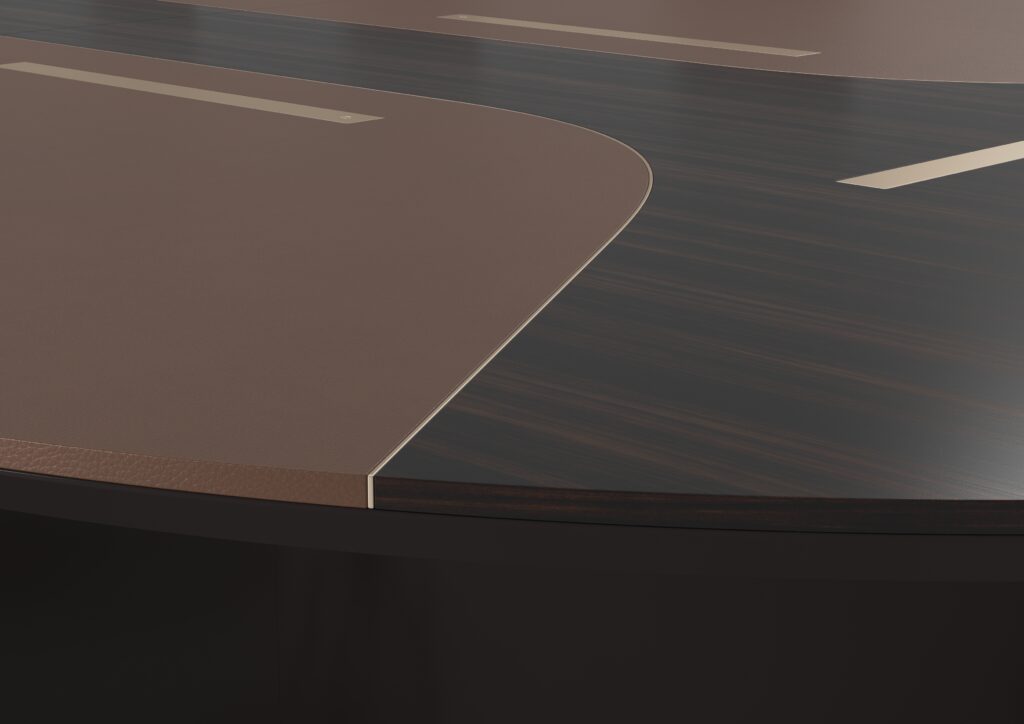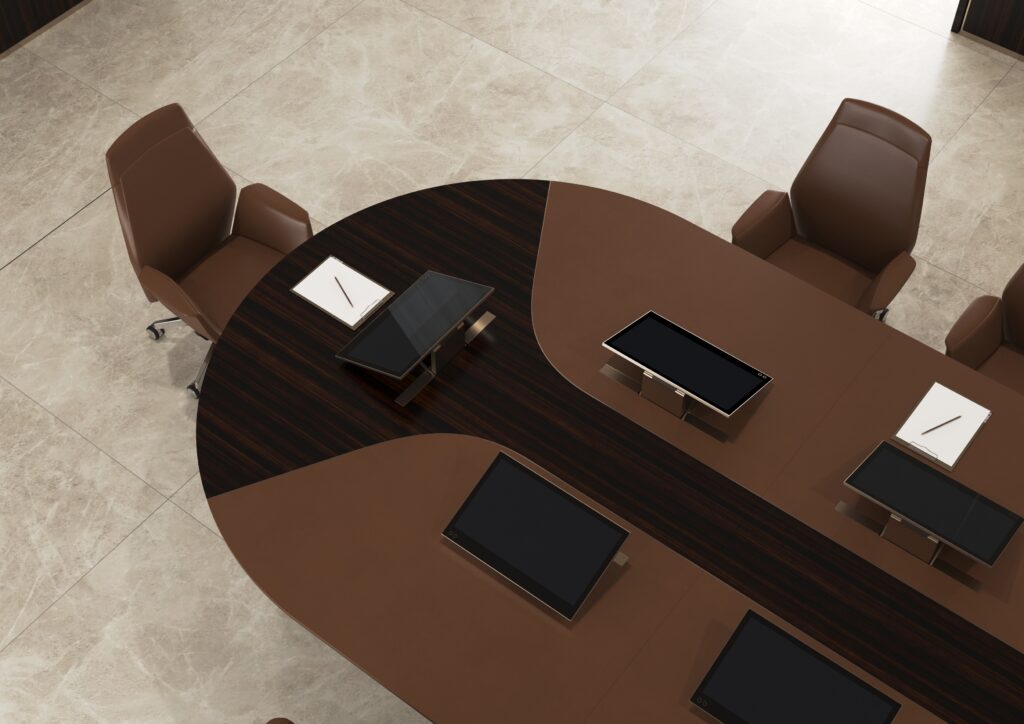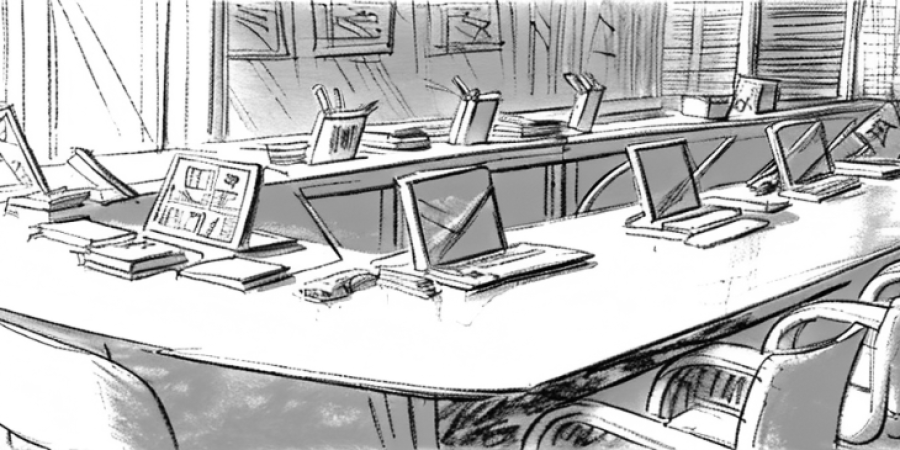“Technology is best when it brings people together.” — Matt Mullenweg
Meetings are the foundation of decision-making and collaboration in any organization. While their effectiveness relies on participant engagement and communication, the design of the meeting table and the technology integrated into the space play a crucial role in shaping interactions.
Neuroarchitecture, the interdisciplinary field that merges neuroscience with architectural design, plays a crucial role in shaping spaces that enhance cognitive function, well-being, and productivity. In the context of corporate environments, especially boardrooms, neuroarchitecture significantly influences the design of furniture, such as boardroom tables. These tables are the focal point of discussions, decision-making, and collaboration.
Every choice, from table shape to the integration of technology, influences behavior, participation levels, and decision quality. To create more effective and inclusive communication environments, we must understand how these elements affect human psychology in meetings.
The Psychology of Meeting Table Design
The meeting table is the central element of any discussion space. Its design significantly impacts communication flow, team dynamics, and decision-making processes.
The Power of Shape
Research in neuroarchitecture suggests that circular or oval tables promote inclusivity, equal participation, and open dialogue, as they eliminate hierarchical positioning. Conversely, rectangular tables, often associated with traditional corporate settings, reinforce a structured hierarchy where individuals at the head positions exert greater influence.

- Round Tables: Promote inclusivity and equality, as all participants sit at equal distances, fostering unity and collaboration. Inspired by the legendary King Arthur’s Round Table, this setup encourages open and fair discussions.
- Rectangular Tables: Encourage formality and hierarchy, with leaders typically positioned at the head, directing conversation flow.
- U-Shaped or Horseshoe Tables: A mix of round and rectangular, offering a balance between structured leadership and group discussion.
- Modular Tables: Offer flexibility, allowing configurations that adapt to different meeting needs—whether for intimate discussions or large strategic sessions.
Material & Texture: Evoking Emotional Responses

- Wooden and leather Surfaces: Create a warm and inviting atmosphere, encouraging openness and familiarity.
- Glass and Metal: Convey professionalism and modernity, reinforcing a structured and sophisticated setting.

The Power of Proximity: Seating Arrangements and Interaction
Neuroarchitecture emphasizes ergonomic designs that cater to physical comfort, ensuring prolonged focus and reduced fatigue. Boardroom tables should be designed with appropriate height, legroom, and surface space to accommodate varied seating arrangements and technology integration. Adequate spacing between participants fosters a balance between personal space and collaborative interaction, preventing cognitive overload.
- Close seating fosters collaboration and engagement, much like a team handshake.
- Spacing and positioning can either encourage discussion or create barriers to communication.
Technology’s Influence on Meeting Dynamics
Technology is not a passive tool; it actively shapes interaction styles, hierarchy perceptions, and engagement levels.
Modern boardroom tables are often embedded with technology to enhance cognitive efficiency. Features such as built-in power outlets, connectivity, retractable monitors, microphones, cameras, and speakers support seamless collaboration. Neuroarchitecture advocates for intuitive technology placement that minimizes distractions and cognitive strain, ensuring that digital tools enhance rather than hinder productivity.

Screen Layout and Attention Distribution
- Single Large Screen: Centralizes focus, making it effective for formal presentations but limiting participant interaction.
- Multiple Screens: Distributes attention more evenly, supporting a democratic discussion environment and facilitating eye contact, an extremely powerful communication tool. Retractable screens add flexibility, optimize space, and create a “wow” effect.
- Personal Screens (BYOD – Bring Your Own Device): Allow personalized access to content but can introduce distractions.
- Interactive Screens and Touchscreens: Encourage active participation, making discussions more dynamic.
Camera Setup and Hierarchy Perception
- Positioning: Centrally placed cameras at eye level create a balanced communication experience, while overhead or side cameras may unintentionally reinforce hierarchy.
- Cameras Integrated in Each Monitor: Should ensure equal screen space for all participants, avoiding hierarchical biases and providing a perfect capture of each participant’s image.
- Smart Cameras & Eye-Tracking: Advanced technology can improve virtual engagement by simulating natural eye contact and keeping discussions fluid.
The Role of Sound Quality
“The art of communication is the language of leadership.” — James Humes
- Speech Intelligibility: Clear audio reduces cognitive fatigue and enhances focus. High-quality microphones and noise-canceling systems are essential.
- Proximity Sound: Necessary to create a natural acoustic environment.
- Room Acoustics: Poor acoustics can create distractions. Strategic soundproofing and microphone placement improve clarity and participation.
Conclusion
Both table design and technology play a profound role in meeting psychology. Shape, material, seating arrangement, screen placement, camera setup, and sound quality all contribute to engagement, hierarchy perception, and decision-making efficiency. By making intentional choices in these areas, organizations can foster more inclusive, effective, and engaging meeting environments.
As technology continues to evolve, thoughtful integration will remain crucial in optimizing workplace collaboration.
